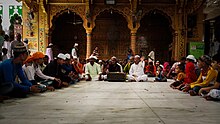
Back دركاه Arabic দরগাহ Bengali/Bangla درگاه (معماری) Persian Dargah French दरगाह Hindi Dorgah ID Dargah Italian ದರಗ Kannada ദർഗ്ഗ Malayalam ਦਰਗਾਹ Punjabi
| Part of a series on Islam Sufism |
|---|
 |
|
|





A dargah (Persian: درگاه dargâh or درگه dargah, Turkish: dergâh, Hindustani: dargāh दरगाह درگاہ, Bengali: দরগাহ dôrgah) is a shrine or tomb built over the grave of a revered religious figure, often a Sufi saint or dervish. Sufis often visit the shrine for ziyarat, a term associated with religious visitation and pilgrimages. Dargahs are often associated with Sufi eating and meeting rooms and hostels, called khanqah or hospices. They usually include a mosque, meeting rooms, Islamic religious schools (madrassas), residences for a teacher or caretaker, hospitals, and other buildings for community purposes.
The same structure, carrying the same social meanings and sites of the same kinds of ritual practices, is called maqam in the Arabic-speaking world.
Dargah today is considered to be place where saints prayed and mediated (their spiritual residence). Shrine is modern day building which encompasses of actual dargah as well but not always.
© MMXXIII Rich X Search. We shall prevail. All rights reserved. Rich X Search